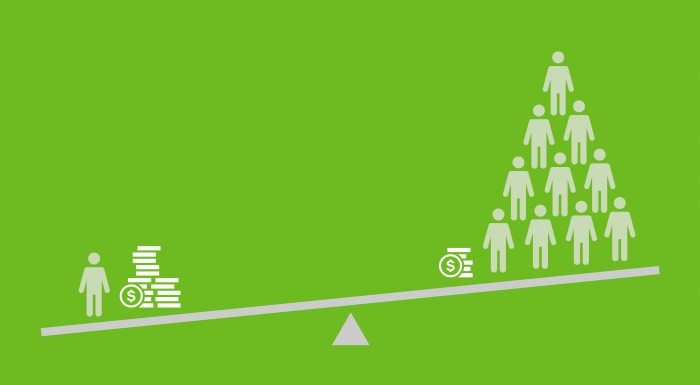Oxfam, a non-profit organization that seeks to combat global poverty, recently released a report decrying the growth in global wealth inequality. In the report, Oxfam claimed that the 62 wealthiest people in the world own more wealth than the rest of the global population combined. While the conclusions of Oxfam’s study may seem terrifying, the report itself suffers from severe methodological deficiencies that lead to skewed and misleading results. It paints an excessively pessimistic picture about the state of humanity by failing to account for the sharp fall in global poverty and reduced global inequality. The frantic response in the media is therefore disproportionate to the reality of inequality.
To come up with statistics on global wealth inequality, Oxfam relies on crude and unsophisticated methods that don’t accurately reflect the opportunities available to people globally, or disparities in economic well-being. In order to produce relevant data, Oxfam simply subtracted an individual's debts from their assets to reach a ‘net wealth’ figure. While technically accurate, such methods can produce very distorted results.
According to Oxfam’s methodology, which is based on material wealth, many of the poorest people in the report are those who reside in some of the most affluent nations in the world. For example, a recent law school graduate who took on a lot of debt is likely to be classed as less well-off than a farmer in an economically developing nation that has little or no debt, but only meager assets. This is because despite facing much less fortuitous economic prospects, the farmer still has a positive, albeit small, net worth, while the university student has an excess of liabilities over assets. Thus, the statistics produced by Oxfam actually say very little about the well-being of the people in various countries around the world. It would be difficult to argue that the law school graduate in an economically developed nation is less well off and faces worse prospects than the farmer.
The report also fails to reflect the massive welfare gains the poorest individuals in the world have experienced over the past quarter of a century. According to the World Bank, in 1990 approximately 37 per cent of the world’s population lived below its definition of the international poverty line, which is at $1.90 USD a day. The World Bank forecasted that by 2015 only 9.6 per cent of the global population—702 million people—would have incomes that fall below this threshold. While inequality and poverty are often conflated, they are two very separate issues. Inequality means some have more than others, while poverty is indicative of an individual having insufficient resources to meet their basic needs and fully participate in society.
While the former phenomenon may be unpleasant to some, the latter is of vastly greater importance. In essence, it matters far more in terms of human welfare that people don’t suffer destitution and can meet their basic needs than for the gap between different income groups to be narrower. Despite the gloom and doom of the Oxfam report, life is improving for some of the world’s most desperately poor people. In fact, the recent reductions in international poverty have been so rapid that many analysts believe that the virtual elimination of absolute poverty could be achieved globally by 2030.
While it is true that income inequality has become more acute within many developed nations, the income gap between poor and rich nations has fallen sharply in recent years. Economist Branko Milanovic has shown that over the past two decades, economic growth (both in terms of total output and per capita) in developing nations (led by China and India) has far outstripped that in developed nations. The biggest rises in income on a global level have accrued to individuals who fall in a range from the 10th to 70th percentile of the global income distribution. From 1988 to 2008, individuals who fall within such a range saw a real (inflation adjusted) pay rise of around 40 per cent. This, coupled with slower income growth for workers in developed nations, has led to steady falls in the income gap between developing and developed nations. Again, this increase in global income equality is a far cry from the tone of despair in the Oxfam report.
The report also exaggerates global wealth inequality by drastically understating the assets that billions of people worldwide have claim to. Tim Worstall contends that if items such as private pensions and medical benefits are (rightly) counted as assets owned by individuals, then it is only logical that similar public benefits, such as the Canada Pension Plan, are also counted as adding to individual wealth. The distinction between the two types of assets is a social construct. While one may be privately provided and the other publically provided, both a private and a public pension entitle the beneficiary a claim to a future stream of income that has a capitalized market value. Doing so would likely dramatically narrow the large disparities in holdings of wealth.
Even if the dubious methodology of the report is discounted, other sources of data show a steady decline in global poverty. Far from becoming the Dickensian dystopia portrayed in the report, the world is becoming one of less poverty and more equality. Moreover, it is questionable whether wealth inequality is even the core issue facing the world. Reducing poverty further and increasing opportunity for the global poor would do much more to make the world a better place. To boost global welfare, it is more important to focus on raising the absolute living standards of people in the poorest nations than it is to focus on the wealth of a few individuals.








